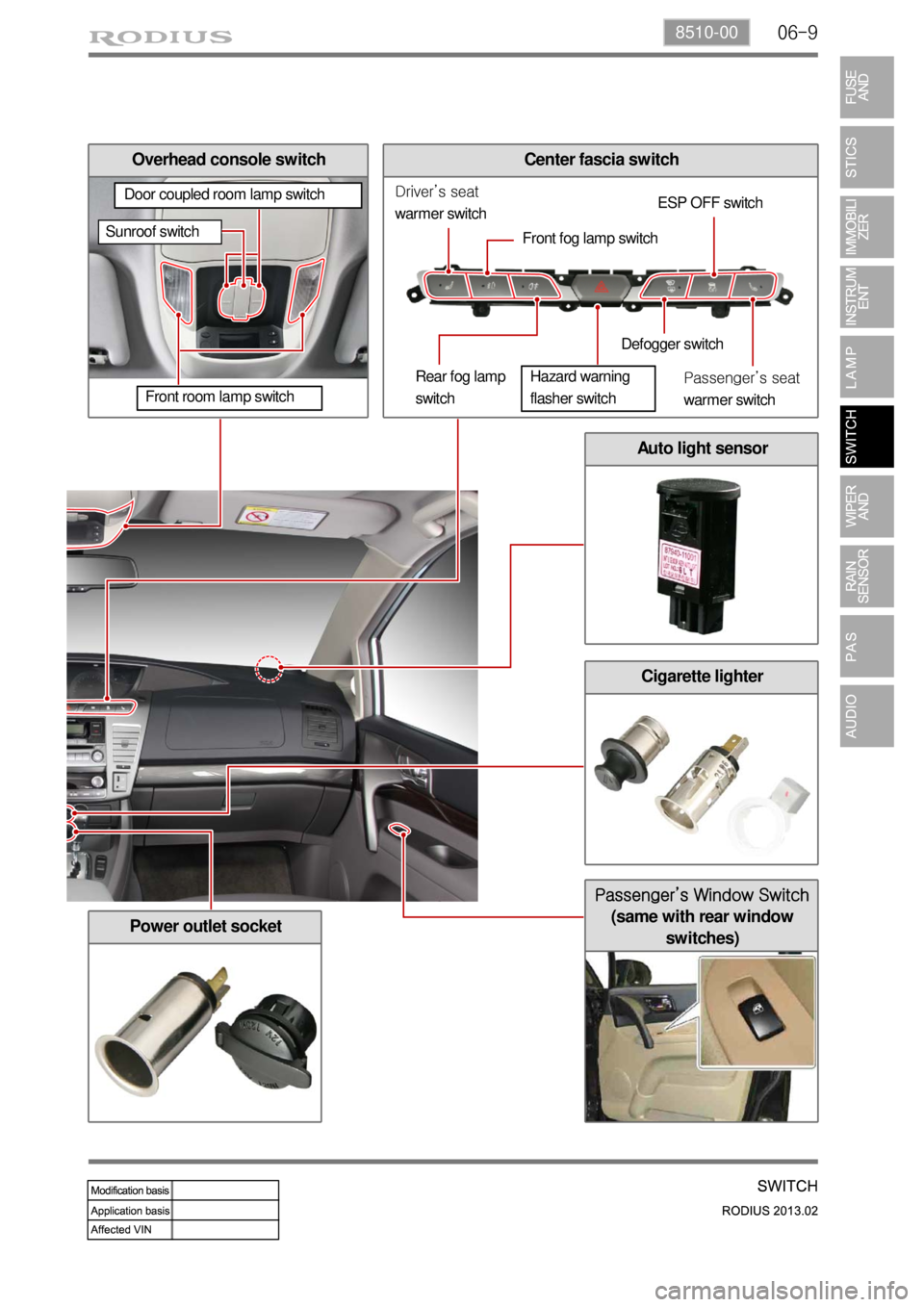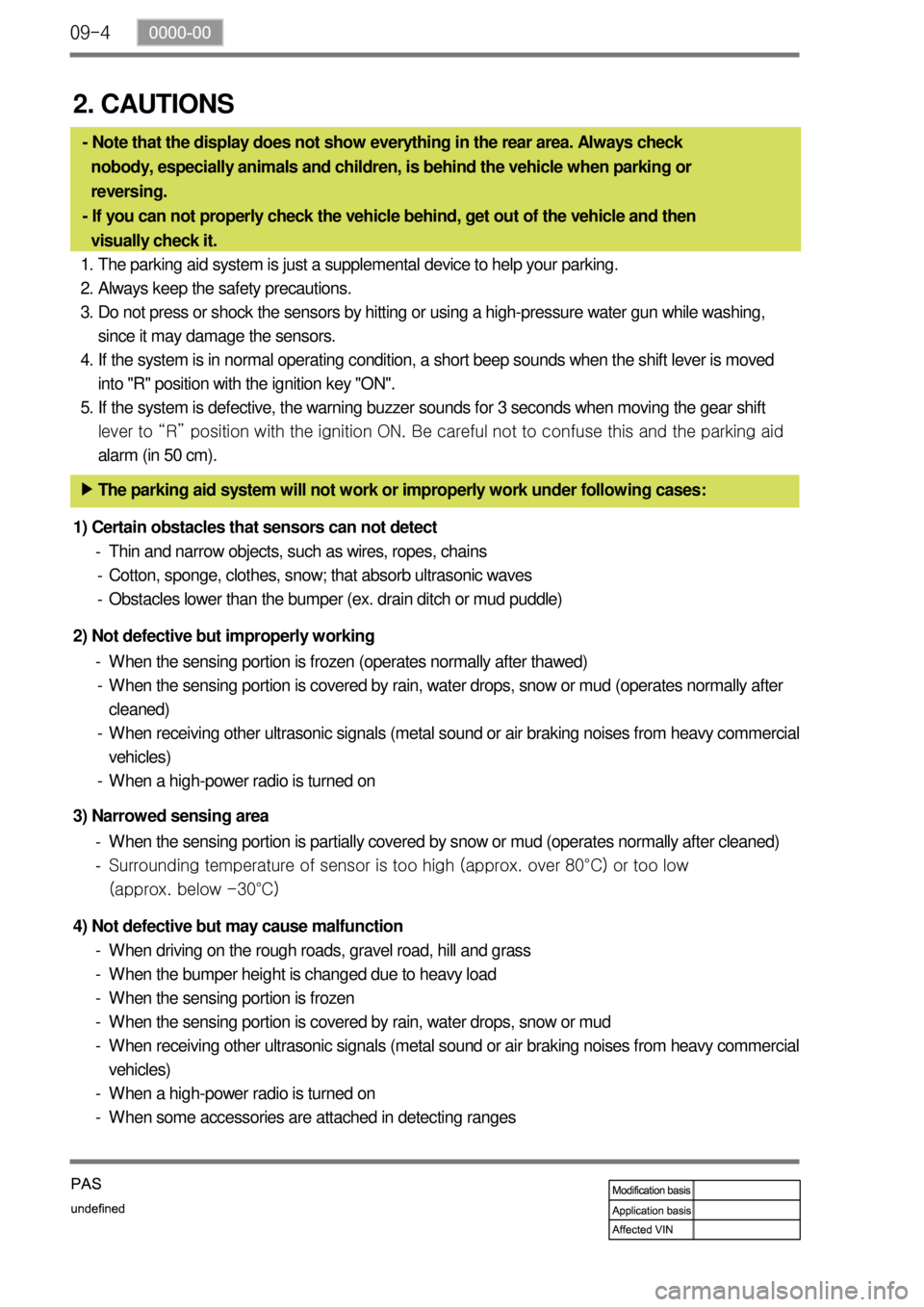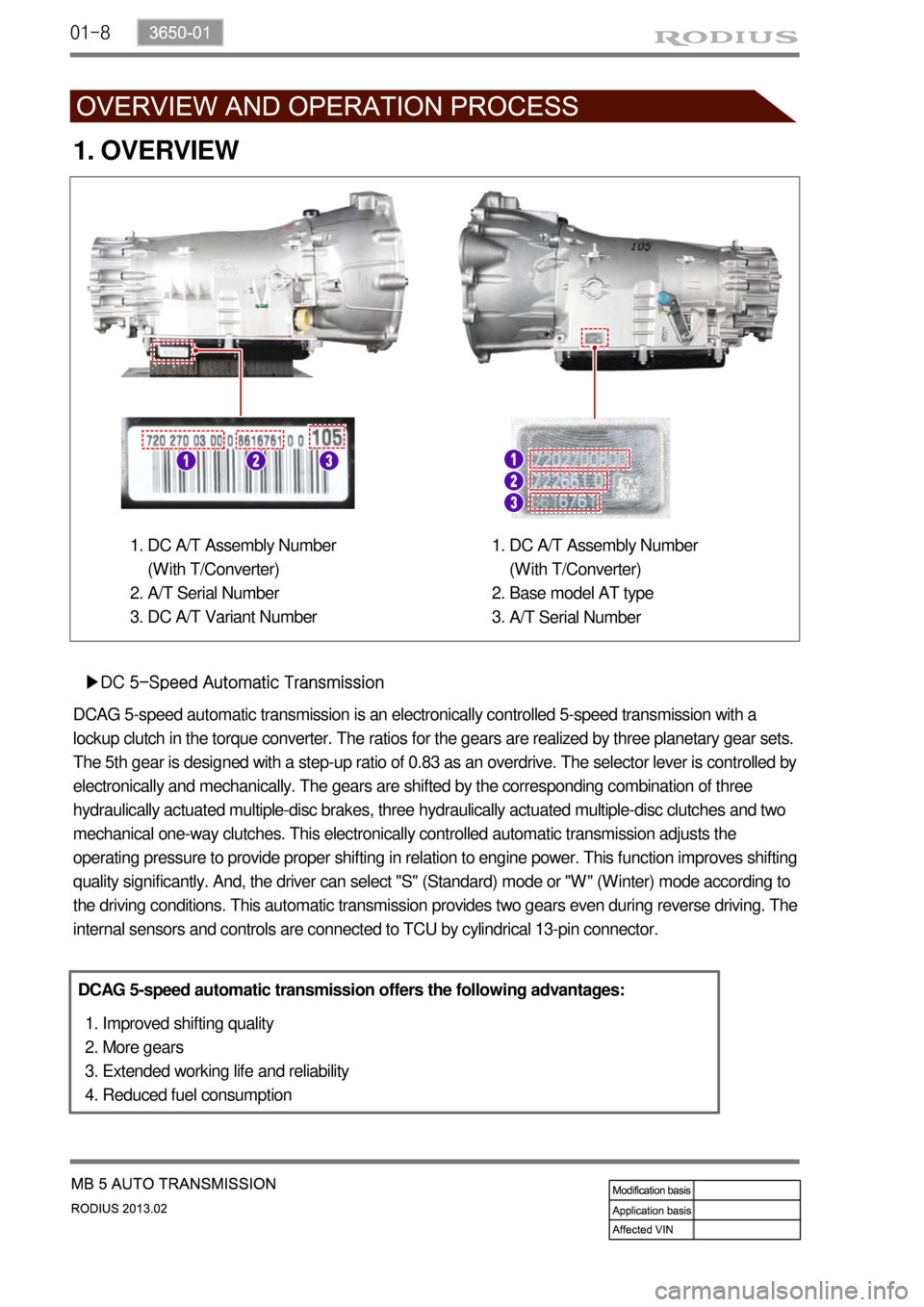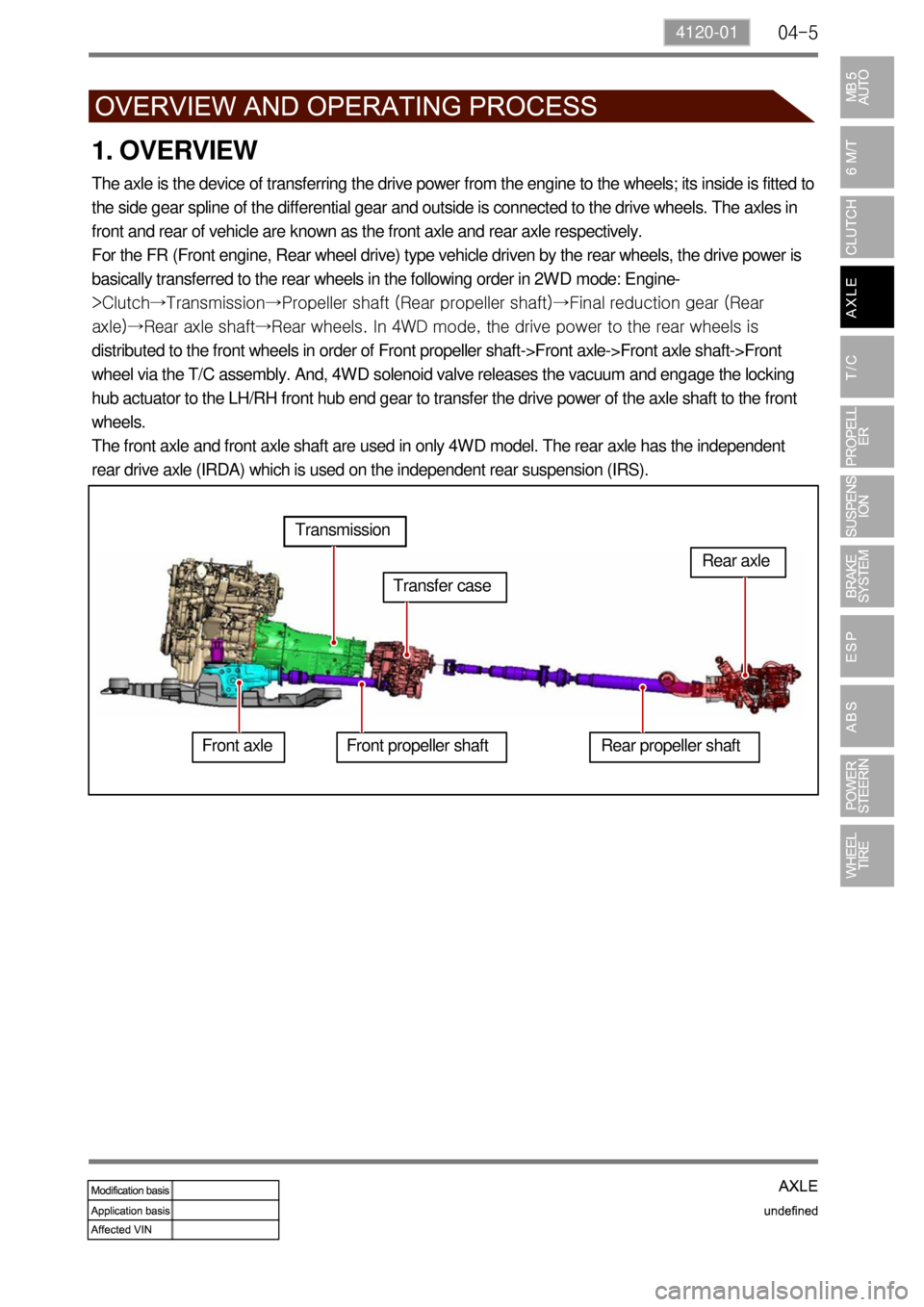ESP SSANGYONG TURISMO 2013 Owner's Manual
[x] Cancel search | Manufacturer: SSANGYONG, Model Year: 2013, Model line: TURISMO, Model: SSANGYONG TURISMO 2013Pages: 796, PDF Size: 78.99 MB
Page 356 of 796

15-28
Electric throttle
bodyAccelerator
pedal
moduleD20DTR
ECU
(9) EGR control
A. Overview
The EGR (Electric-Exhaust Gas Recirculation) valve reduces the NOx emission level by recirculating
some of the exhaust gas to the intake system.
To meet Euro-V regulation, the capacity and response rate of E-EGR valve in D20DTR engine have
been greatly improved. The EGR cooler with high capacity reduces the Nox, and the bypass valve
reduces the CO and HC due to EGR gas before warming up.
Also, the engine ECU adjusts the E-EGR opening by using the air mass signal through HFM sensor. If
the exhaust gas gets into the intake manifold when the EGR valve is open, the amount of fresh air
through HFM sensor should be decresed.
B. Components
E-EGR cooler
Coolant
temperature
sensorOxygen sensor
HFM (intake
air
temperature)
Crankshaft
position
sensorE-EGR valve
T-MAP
sensor
Page 408 of 796

10-38510-23
1. CRUISE CONTROL SWITCH
The cruise control is an automatic speed control system that maintains a desired driving speed without
using the accelerator pedal.
The vehicle speed must be greater than 36 km/h to engage the cruise control. This feature is
especially useful for motorway driving.
The cruise control system is a supplementary system, which helps the driver to drive the vehicle at
a desired speed without using the accelerator pedal under the traffic condition where the vehicle-to-
vehicle distance meets the legal requirement.
Page 414 of 796

10-98510-23
5) Normal Cancellation of the Cruise Control
The cruise control system will be canceled when one or more items of the following conditions are
applied;
Keep the main cruise control switch in the neutral position when not using the cruise control.When the brake pedal is depressed.
When the cruising speed is downed less than 38 km/h.
When the OFF switch is operated by pulling the cruise control lever (Type A) or by pushing the ON-
OFF switch of the cruise control lever (Type B).
When ESP is activated.
When applying the parking brake when driving.
When using the clutch in order to shift (M/T only).
And the cruise control system can be operated again in driving state. 1.
2.
3.
4.
5.
6.
Page 482 of 796

03-8
Transponder
3. VERIFICATION OF KEY
1) Verification
The immobilizer system prevents the vehicle theft by allowing only the authorized key to start the
engine. The transponder inside the key communicates with the immobilizer installed in the key box,
and the system permits the engine to start after confirming the encrypted coding from the engine ECU.
In the following cases, a driver may be unable to start the vehicle with the immobilizer.The immobilizer unit transmits
the encrypted code to the
transponder. (2)
The transponder sends an encrypted signal to the unit as a response.
The transmitted code is changed to an encrypted signal in the unit.
The system compares the signal from transponder and the encrypted signal in immobilizer unit. (3)
(4)
(5)
When two or more immobilizer keys come into contact with (each) other(s).
When the key is close to any device sending or receiving electromagnetic fields or waves.
When the key is close to any electronic or electric devices such as lightening equipment,
security keys or security cards.
When the key is close to a magnetic or metal object or a battery. -
-
-
-
Immobilizer Unit
Page 503 of 796

06-38510-00
1. SPECIFICATIONS
1) Center Fascia Switch
Item Specifications
Center fascia switch &
bezel assemblyHazard warning flasher switch DC 12 V 10 A(lamp load)
Windshield heated glass switch
DC 12 V 1 A(inductive load) Rear heated glass switch
ESP OFF switch
Driver/front passenger seat warmer
switch
Fog lamp switch
2) 4WD Switch & HLLD Switch & Rear Wiper Operation Switch
Item Specifications
4WD switch &
HLLD switch &
rear wiper operation
switch assemblyWasher switch DC 12 V 3.8 A(lamp load)
Wiper switch DC 12 V 3.0 A (max. 10 A)
4WD switch DC 12 V 300 mA
HLLD switch DC 12 V 1 A (inductive load)
3) Steering Wheel Switch
Item Specifications
Steering wheel switch Rated voltage DC 5 V 0.1 A(rated load)
Operation temperature-30‚ĄÉ~+80‚ĄÉ
Page 509 of 796

06-98510-00
Center fascia switch
Passenger’s Window Switch
(same with rear window
switches)
Overhead console switch
Auto light sensor
Cigarette lighter
Power outlet socket
Driver’s seat
warmer switch
Rear fog lamp
switchESP OFF switch
Defogger switch
Passenger’s seat
warmer switch Front fog lamp switch
Front room lamp switch
Sunroof switch
Door coupled room lamp switch
Hazard warning
flasher switch
Page 511 of 796

07-4
2. CAUTIONS ON RAIN SENSOR
When the wiper switch is in the AUTO position, the wiper will operate for 1 cycle if the initial engine
start is made. This may cause the wiper blades to wear prematurely. Therefore, other than rainy
days, set the switch to the OFF position. Especially during the winter time, check if the wiper blades
are not frozen to the windshield.
Operating the wiper with the blades frozen can damage the wiper motor.
If you operate the wipers when the windshield is dry without spraying washer fluid, the windshield can
be scratched and the wiper blades can wear prematurely. Use the wiper with the washer fluid when
the windshield is dry.
When it does not rain, turn the wiper switch to the OFF position.
Turn the wiper switch to the OFF position before any car wash to avoid unwanted operation of the
wipers. -
-
-
-
When cleaning the windshield over the sensor with damp clothes, the wiper may operate suddenly.
It could cause serious injury. Make sure to place the wiper switch to the OFF position and ignition
switch OFF when not in use.
Irregular operation (abrupt operation) ‚Ė∂
Check if the sensor is off the position.
Check if the rain sensor cover is securely installed.
Check if the customer is familiar to how to control the wiper sensitivity.
Check if the wiper sensitivity control is set to the FAST side (step 5).
Check the wiper blade for wear.
If the wiper blade cannot wipe the glass uniformly and clearly, it may cause the rain sensor to work
irregularly. Therefore, in this case, replace the wiper blade with a new one. -
-
-
-
Page 531 of 796

09-4
2. CAUTIONS
The parking aid system is just a supplemental device to help your parking.
Always keep the safety precautions.
Do not press or shock the sensors by hitting or using a high-pressure water gun while washing,
since it may damage the sensors.
If the system is in normal operating condition, a short beep sounds when the shift lever is moved
into "R" position with the ignition key "ON".
If the system is defective, the warning buzzer sounds for 3 seconds when moving the gear shift
lever to ‚ÄúR‚ÄĚ position with the ignition ON. Be careful not to confuse this and the parking aid
alarm (in 50 cm). 1.
2.
3.
4.
5.
- Note that the display does not show everything in the rear area. Always check
nobody, especially animals and children, is behind the vehicle when parking or
reversing.
- If you can not properly check the vehicle behind, get out of the vehicle and then
visually check it.
The parking aid system will not work or improperly work under following cases: ‚Ė∂
1) Certain obstacles that sensors can not detect
Thin and narrow objects, such as wires, ropes, chains
Cotton, sponge, clothes, snow; that absorb ultrasonic waves
Obstacles lower than the bumper (ex. drain ditch or mud puddle) -
-
-
2) Not defective but improperly working
When the sensing portion is frozen (operates normally after thawed)
When the sensing portion is covered by rain, water drops, snow or mud (operates normally after
cleaned)
When receiving other ultrasonic signals (metal sound or air braking noises from heavy commercial
vehicles)
When a high-power radio is turned on -
-
-
-
3) Narrowed sensing area
When the sensing portion is partially covered by snow or mud (operates normally after cleaned)
Surrounding temperature of sensor is too high (approx. over 80¬įC) or too low
(approx. below -30¬įC) -
-
4) Not defective but may cause malfunction
When driving on the rough roads, gravel road, hill and grass
When the bumper height is changed due to heavy load
When the sensing portion is frozen
When the sensing portion is covered by rain, water drops, snow or mud
When receiving other ultrasonic signals (metal sound or air braking noises from heavy commercial
vehicles)
When a high-power radio is turned on
When some accessories are attached in detecting ranges -
-
-
-
-
-
-
Page 559 of 796

01-8
1. OVERVIEW
‚Ė∂DC 5-Speed Automatic Transmission
DCAG 5-speed automatic transmission is an electronically controlled 5-speed transmission with a
lockup clutch in the torque converter. The ratios for the gears are realized by three planetary gear sets.
The 5th gear is designed with a step-up ratio of 0.83 as an overdrive. The selector lever is controlled by
electronically and mechanically. The gears are shifted by the corresponding combination of three
hydraulically actuated multiple-disc brakes, three hydraulically actuated multiple-disc clutches and two
mechanical one-way clutches. This electronically controlled automatic transmission adjusts the
operating pressure to provide proper shifting in relation to engine power. This function improves shifting
quality significantly. And, the driver can select "S" (Standard) mode or "W" (Winter) mode according to
the driving conditions. This automatic transmission provides two gears even during reverse driving. The
internal sensors and controls are connected to TCU by cylindrical 13-pin connector.
DCAG 5-speed automatic transmission offers the following advantages:
Improved shifting quality
More gears
Extended working life and reliability
Reduced fuel consumption 1.
2.
3.
4.
DC A/T Assembly Number
(With T/Converter)
A/T Serial Number
DC A/T Variant Number 1.
2.
3.DC A/T Assembly Number
(With T/Converter)
Base model AT type
A/T Serial Number 1.
2.
3.
Page 600 of 796

04-54120-01
1. OVERVIEW
The axle is the device of transferring the drive power from the engine to the wheels; its inside is fitted to
the side gear spline of the differential gear and outside is connected to the drive wheels. The axles in
front and rear of vehicle are known as the front axle and rear axle respectively.
For the FR (Front engine, Rear wheel drive) type vehicle driven by the rear wheels, the drive power is
basically transferred to the rear wheels in the following order in 2WD mode: Engine-
>Clutch‚ÜíTransmission‚ÜíPropeller shaft (Rear propeller shaft)‚ÜíFinal reduction gear (Rear
axle)‚ÜíRear axle shaft‚ÜíRear wheels. In 4WD mode, the drive power to the rear wheels is
distributed to the front wheels in order of Front propeller shaft->Front axle->Front axle shaft->Front
wheel via the T/C assembly. And, 4WD solenoid valve releases the vacuum and engage the locking
hub actuator to the LH/RH front hub end gear to transfer the drive power of the axle shaft to the front
wheels.
The front axle and front axle shaft are used in only 4WD model. The rear axle has the independent
rear drive axle (IRDA) which is used on the independent rear suspension (IRS).
Front axleTransmission
Transfer case
Front propeller shaft Rear propeller shaftRear axle